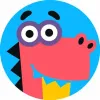Take a look inside 13 images
Happy Numbers
Pros: Scaffolding creates seamless connections from concrete models to the abstract.
Cons: Scores for growth and progress are shown, but it's missing student responses that could aid in identifying misconceptions.
Bottom Line: Depth of concepts covered and expertly paced lessons are sure to develop mathematical thinkers.
Happy Number's curriculum makes it a strong choice for on-track learning as well as a remediation tool. Students have an opportunity to build conceptual understanding and repair misconceptions using Happy Numbers’ virtual manipulatives, charts, and models. Teachers can individualize curriculum by including or excluding individual standards or whole modules, ensuring students get help for the topics they need. The reports, which show both growth and progress, can easily be turned into RTI data for students at any level of intervention.
Space- and dinosaur-themed incentives will help keep the excitement alive. Teachers can hang solar system mobiles for each kid and add die-cut planets as skills have been mastered -- perhaps coloring a picture of the dinosaur friends will help kids mark their success.
Teachers can feel comfortable allowing students independent time to use this program. Nonreaders have access to a voice-over tool that's clear and offers both English and Spanish translations.
Happy Numbers is an adaptive math learning program for K-5 students. This program stands out from the rest with a scaffolded approach that carefully leads the students through the lessons. The approach begins with an easy interaction with virtual manipulatives, then incrementally blends in other models and charts, demonstrates correct use of mathematical language, and finally reaches the abstract algorithms. This all takes place in a well-orchestrated set of lessons and questions that ensure success.
Beginning with a pre-test, each student is set on their own personalized journey. Kids travel the planets in Dino the dinosaur's solar system and search out Dino's friends. Each planet covers a set of skills that have been assigned based on the pre-test, which can be reset at any time to be sure kids are on the right path. Teachers even have access to the curriculum assignments to remove standards as they see fit.
Landing on a planet begins to crack open a dinosaur egg, and working through lessons allows a new dinosaur friend to emerge. Students must remain on the same planet until the egg has cracked, but once a lesson is done, kids can move to another planet if they want a change of scenery. No marathon models here; each planet has only a few lessons, which makes success easy to achieve and keeps students excited for more.
Happy Numbers teaches each piece just the way a classroom teacher would, allowing for a little exploration, but not allowing students to stray off the mark without a redirection. If a wrong answer is entered, the program gives hints, redirects, and eventually asks the student to use virtual manipulatives or charts to work the problem as a guided task.
Happy Number's lessons are well constructed to develop a deep understanding of each skill. Expertly connecting problems to virtual manipulatives, then building in the language and algorithm, Happy Numbers leaves very little room for misconceptions. Reports display usable data by class, or teachers can narrow their focus with a progress report for a single student and view their assignments. The ability to view specific student responses to each question isn't available, which would help teachers identify misunderstandings, but the score for each lesson as well as examples of questions are available within the report.





















